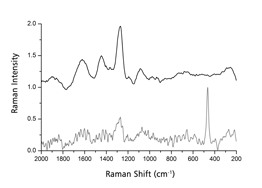Uses laser beams to obtain information about the molecular composition of samples.
dating
morphology
technology
origin
composition
alteration

Ceramic

Glass

Metal

Mortar

Pigments

Stone
Ceramic Building Materials (CBM)
Provides information about the chemical composition of different mineralogical phases in the ceramic body, the nature of the raw materials used to produce them, the glaze and pigments used for their coating. Eventually this information can lead to indirect chronological and/or geographical assignment by comparison with spectra of ceramic objects of known provenance or with online spectral databases.
Glass
Glass specimen can be characterized (nature, indirect dating, production technique),as they give different bands depending on the additives contained in their silica structure, as well as the pigments used to decorate stained glass.
Glass weathering products or conservation material from previous conservation treatments can also be examined with Raman spectroscopy.
Metals & Alloys
Raman spectroscopy is not sensitive to metals, due to the fact that light is mostly refl ected mirror-like, instead of being scattered. However, the method can be used to detect and characterize corrosion products of metals and alloys (Vandenabeele et al., 2006) such as metal oxides, which can help understand the causes of corrosion.
Mortar & Plaster
Nature of the binder and the aggregates of mortars and plasters can be identified.
Further characterization includes analyzing their degradation products (e.g. soluble salts) and/or the pigments of murals and frescoes.
Pigments
In addition to determining the chemical composition of pigments on any specimen, Raman spectroscopy can also be employed in the identification of organic binding media and varnishes of paintings (although this process is not easy, due to the fluorescence of these materials). Moreover, the detection of precious pigments may help indicate the purpose of the object (e.g expensive pigments like lapis lazuli would not be used in everyday objects).
Stone
Stone analysis by means of Raman spectroscopy allows the characterization of inclusions in minerals for provenance studies. Usually the unknown sample and a reference of known origin are measured and their spectra are compared.
Raman is often applied on degradation products and encrustations of historical building stones, on layers of previous conservation interventions and on evaluation analyses of cleaning treatments .

Raman spectrum. Image by Nora Pérez Castellanos
Raman spectroscopy is a reliable and sensitive diagnostic analytical technique for non-destructive surface and multi-layer chemical characterization of materials used in historical buildings and in numerous other works of art. Chemical characterization by means of Raman spectroscopy includes both compositional and crystal* form information of organic and inorganic compounds* in samples (solid, liquid, gas). Moreover, by identifying the chemical composition of a large number of different spots on a specimen, chemical mapping can be performed.
accuracy
time
cost
in situ
invasive
destructive
The method consists in sending a monochromatic light beam on a specimen and analyzing the scattered light resulting from the interaction between the material’s molecules and the beam. The light source used in Raman spectroscopy is usually a laser beam. As a result Raman bands* correspond to the frequency of the detected photons. Compounds* are easily identified by comparing the obtained Raman spectra with reference spectra found in numerous digital spectral libraries published (Vandenabeele et al., 2006) or by assigning characteristic bands separately.